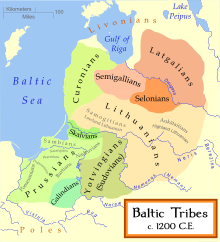
The Baltic languages are a branch of the Indo-European language family spoken natively or as a second language by a population of about 6.5–7.0 million people mainly in areas extending east and southeast of the Baltic Sea in Europe. Together with the Slavic languages, they form the Balto-Slavic branch of the Indo-European family.

The Balts or Baltic peoples are an ethno-linguistic group of peoples who speak the Baltic languages of the Balto-Slavic branch of the Indo-European languages.

Old Prussian was a West Baltic language belonging to the Baltic branch of the Indo-European languages, which was once spoken by the Old Prussians, the Baltic peoples of the Prussian region. The language is called Old Prussian to avoid confusion with the German dialects of Low Prussian and High Prussian and with the adjective Prussian as it relates to the later German state. Old Prussian began to be written down in the Latin alphabet in about the 13th century, and a small amount of literature in the language survives.
Sudovian was a West Baltic language of Northeastern Europe. Sudovian was closely related to Old Prussian. It was formerly spoken southwest of the Nemunas river in what is now Lithuania, east of Galindia and in the north of Yotvingia, and by exiles in East Prussia.
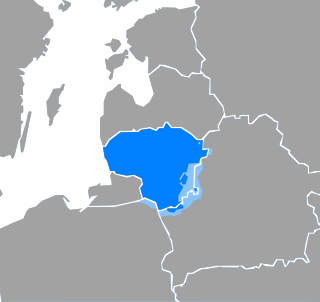
Lithuanian is an East Baltic language belonging to the Baltic branch of the Indo-European language family. It is the official language of Lithuania and one of the official languages of the European Union. There are approximately 2.8 million native Lithuanian speakers in Lithuania and about 1,000,000 speakers elsewhere. Around half a million inhabitants of Lithuania of non-Lithuanian background speak Lithuanian daily as a second language.

Yotvingians were a Western Baltic people who were closely tied to the Old Prussians. The linguist Petras Būtėnas asserts that they were closest to the Lithuanians. The Yotvingians contributed to the formation of the Lithuanian state.
Lithuanian mythology is the mythology of Lithuanian polytheism, the religion of pre-Christian Lithuanians. Like other Indo-Europeans, ancient Lithuanians maintained a polytheistic mythology and religious structure. In pre-Christian Lithuania, mythology was a part of polytheistic religion; after Christianisation mythology survived mostly in folklore, customs and festive rituals. Lithuanian mythology is very close to the mythology of other Baltic nations – Prussians, Latvians, and is considered a part of Baltic mythology.

Saulė is a solar goddess, the common Baltic solar deity in the Lithuanian and Latvian mythologies. The noun Saulė/Saule in the Lithuanian and Latvian languages is also the conventional name for the Sun and originates from the Proto-Baltic name *Sauliā > *Saulē.

The Balto-Slavic languages form a branch of the Indo-European family of languages, traditionally comprising the Baltic and Slavic languages. Baltic and Slavic languages share several linguistic traits not found in any other Indo-European branch, which points to a period of common development and origin.
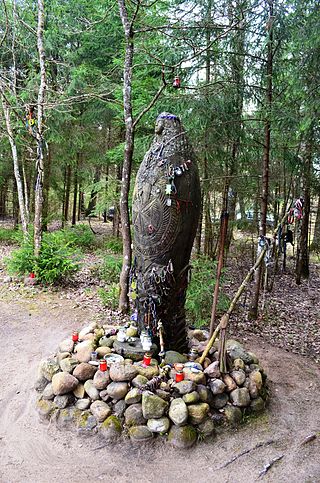
Žemyna is the goddess of the earth in Lithuanian religion. She is usually regarded as mother goddess and one of the chief Lithuanian gods similar to Latvian Zemes māte. Žemyna personifies the fertile earth and nourishes all life on earth, human, plant, and animal. All that is born of earth will return to earth, thus her cult is also related to death. As the cult diminished after baptism of Lithuania, Žemyna's image and functions became influenced by the cult of Virgin Mary.
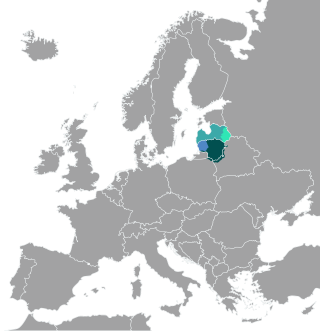
The East Baltic languages are a group of languages that along with the extinct West Baltic languages belong to the Baltic branch of the Indo-European language family. The East Baltic branch has only four living languages—Latvian, Latgalian, Lithuanian, and Samogitian. It also includes now-extinct Selonian, Semigallian, and possibly Old Curonian.

Galindians were two distinct, and now extinct, tribes of the Balts. Most commonly, Galindians refers to the Western Galindians who lived in the southeast part of Prussia. Less commonly, it is used for a tribe that lived in the area of what is today Moscow.

Proto-Baltic is the unattested, reconstructed ancestral proto-language of all Baltic languages. It is not attested in writing, but has been partly reconstructed through the comparative method by gathering the collected data on attested Baltic and other Indo-European languages. It represents the common Baltic speech that approximately was spoken between the 3rd millennium BC and ca. 5th century BC, after which it began dividing into West and East Baltic languages. Proto-Baltic is thought to have been a fusional language and is associated with the Corded Ware and Trzciniec cultures.
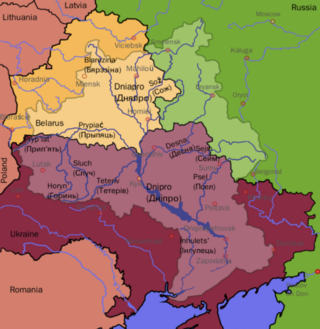
The Dnieper Balts were a subgroup of the Balts that lived in the Dnieper river basin for millennia until the Late Middle Ages, when they were partly destroyed and partly assimilated by the Slavs by the 13th century. To the north and northeast of the Dnieper Balts were the Volga Finns, and to the southeast and south were the ancient Iranians, the Scythians.

Zigmas Zinkevičius was a Lithuanian academician, baltist, linguist, linguistic historian, dialectologist, politician, and the former Minister of Education and Science of Lithuania (1996–1998). Zinkevičius authored over a hundred books, including the popular six-volume "History of the Lithuanian language" (1984–1994), and over a thousand articles, both in Lithuanian and other languages. He was an academician of the Lithuanian Catholic Academy of Science since 1991 and a full member of the Lithuanian Academy of Sciences from 1990 to 2011, when he became an emeritus member.

The Western Baltic culture was the westernmost branch of the Balts, representing a distinct archaeological culture of the Bronze Age and Iron Age, along the southern coast of the Baltic Sea. It is a zone of several small archaeological cultures that were ethnically Baltic and had similar cultural features. They included tribes such as the Old Prussians, Galindians, Yotvingians and Skalvians, in addition to the little-known Pomeranian Balts or Western Balts proper, in the area now known as Pomerania.

The West Baltic languages are a group of extinct Baltic languages that were spoken by West Baltic peoples. West Baltic is one of the two primary branches of Baltic languages, along with East Baltic. It includes Old Prussian, Sudovian, West Galindian, possibly Skalvian and Old Curonian.

The Prussian mythology was a polytheistic religion of the Old Prussians, indigenous peoples of Prussia before the Prussian Crusade waged by the Teutonic Knights. It was closely related to other Baltic faiths, the Lithuanian and Latvian mythologies. Its myths and legends did not survive as Prussians became Germanized and their culture went extinct in the early 18th century. Fragmentary information on gods and rituals can be found in various medieval chronicles, but most of them are unreliable. No sources document pagan religion before the forced Christianization in the 13th century. Most of what is known about Prussian religion is obtained from dubious 16th-century sources.
Antanas Klimas was a prominent Lithuanian doctor of sciences, onomastician and comparative linguist specializing in the relationships between Baltic, Slavic and Germanic language groups as well as the history of Lithuanian language. He also created Lithuanian textbooks and dictionaries, was the editor for the language journal Lituanus, published academic articles on the Lithuanian and Indo-European linguistics. Klimas has written more than 130 publications on linguistics and has made significant contributions to the comparative linguistics of Baltic, Slavic and Germanic languages. He also researched Lithuanian anthroponymy, word formation, phonology and morphology.
